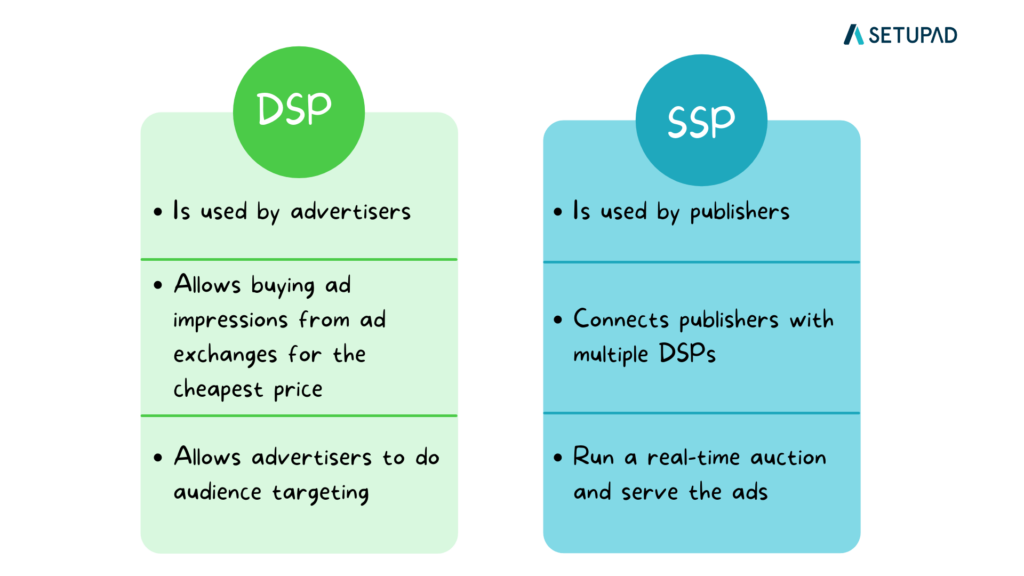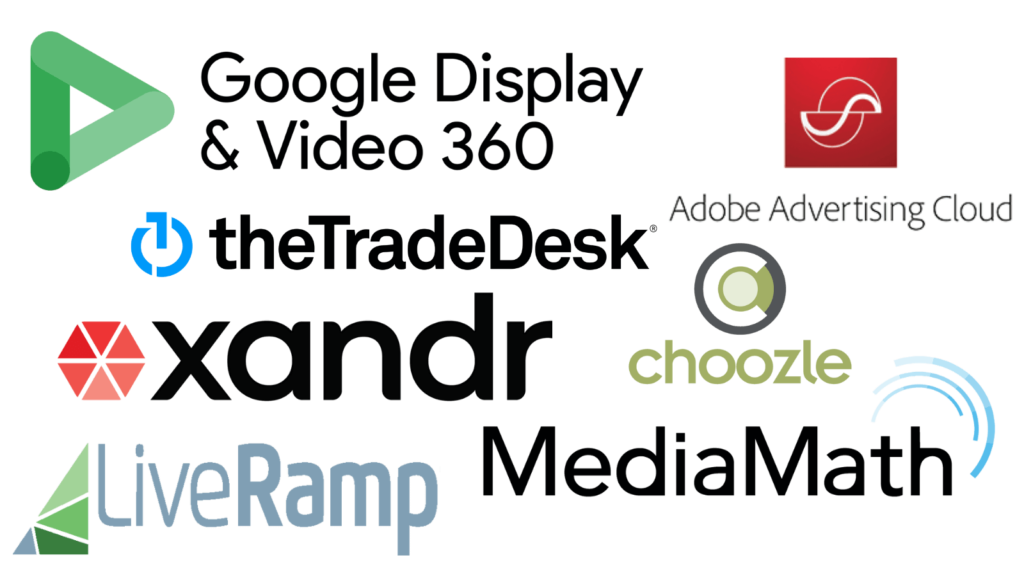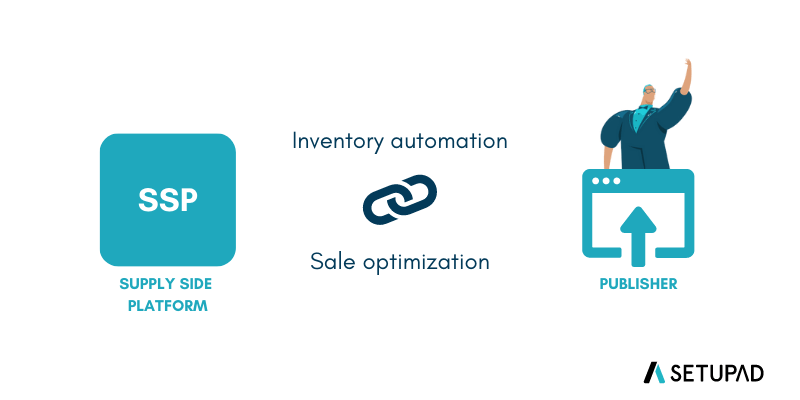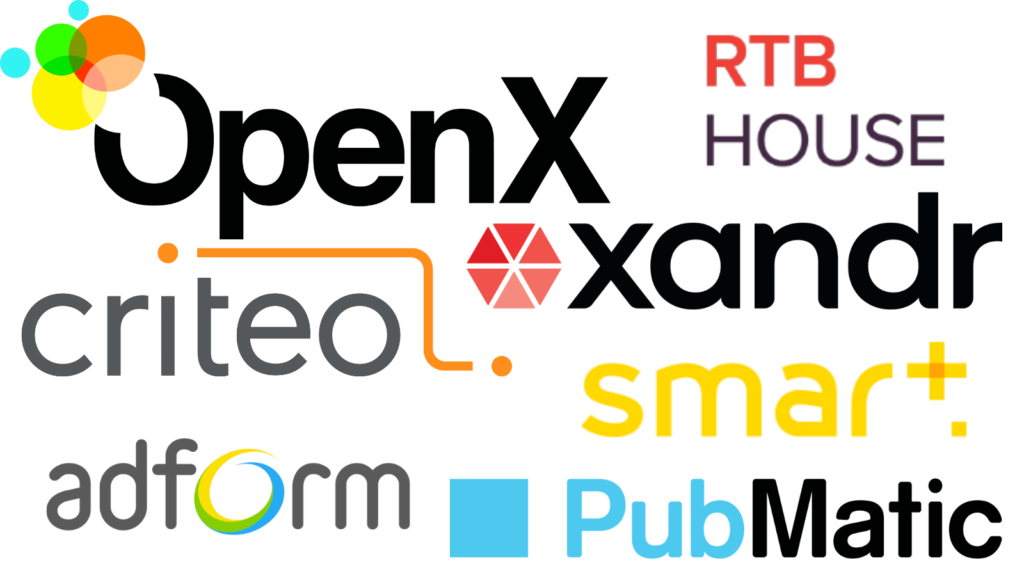Differences Between DSPs, SSPs, and DMPs in Advertising
The main difference between DSPs and SSPs is who uses them: DSPs are for advertisers to buy ad space, while SSPs are for publishers to sell their ad inventory. DSPs help advertisers target audiences efficiently, while SSPs maximize publisher revenue by selling to the highest bidder.
Demand-side platforms (DSP), supply-side platforms (SSP), and data management platforms (DMP) are the building blocks of advertising technology. All those platforms might feel similar, but they are not.
This article explains the key differences between SSP and DSP, the importance of DMP and where they fit in the programmatic advertising ecosystem.
Demand Side Platform (DSP) vs Supply Side Platform (SSP)
A DSP allows advertisers to buy ad impressions across many publishers’ websites most efficiently, while an SSP allows publishers to sell their ad inventory to advertisers at the highest possible price.

What is a Demand Side Platform (DSP)?
A DSP is software used to buy ads automatically. Advertisers use it to buy ad impressions from ad exchanges like Google AdX.

What is an ad exchange?
An ad exchange is where publishers and advertisers combine to trade digital media such as display, video, and mobile ads.
Publishers make their ad inventories available through ad exchanges, while advertisers purchase them via real-time bidding (RTB).
Thus, no humans are involved, and impressions are sold to the highest bidder.
How Does DSP Work?
DSPs allow advertisers to buy ad impressions across multiple publishers’ websites targeted to specific users based on parameters like the users’ location or previous browsing behavior.
They also decide which ad impressions would be the most efficient and cheapest for the advertiser.
From a single interface, DSPs allow advertisers to:
- set ad creatives;
- manage and optimize bids;
- do audience targeting.

The impact of cookie depreciation on the DSP workflow
Cookies have been a primary method for DSPs to target specific audiences based on their browsing behavior. With the demise of third-party cookies in 2024, DSPs face several important challenges in identifying and targeting users accurately.
As a result, DSPs are looking for alternative methods for audience segmentation and targeting, such as first-party data, contextual targeting, Publisher-Provided Identifiers (PPIDs), and other privacy-focused solutions.
However, the question of attribution still remains unclear. Attribution is one of the most crucial metrics in evaluating ad performance. Without it, DSPs face difficulties in accurately tracking user interactions and measuring the effectiveness of campaigns. Therefore, DSPs must adopt new measurement techniques like privacy-centric attribution models and advanced statistical analysis or rely on first-party data provided by publishers or advertisers.
Why use a DSP?
Advertisers and ad agencies need to use a DSP to manage and optimize their digital advertising campaigns accurately. DSPs accumulate vast ad inventory and allow advertisers to reach specific audience segments at a much broader scale.
In addition, DSPs leverage real-time bidding (RTB) technology to participate in ad auctions and bid for ad impressions in milliseconds, allowing advertisers to allocate their budget to high-performing placements and avoid overpaying.
Examples of DSP
Demand-side platform companies like Google Display & Video 360, Xandr, MediaMath, and Adobe Advertising Cloud are some of the best DSPs in adtech.

Many adtech companies (like Xandr) combine SSP and DSP under one roof. Some even integrate both SSP, DSP, and DMP (like Adform).
These full-stack solutions are designed to connect publishers with suitable advertisers and vice versa, helping both the buy and sell sides gain greater efficiency and transparency in managing their advertising operations.
Choosing a DSP depends on specific advertising goals. For example, Google DV360 offers extensive reach and access to Google’s vast inventory, including Google Display Network, YouTube, and other Google-owned properties, while MediaMath has data-driven targeting and optimization capabilities.
Nevertheless, the choice of DSPs may also vary based on factors such as your industry, campaign goals, and desired ad formats.
Here is a list of the best DSP platforms for programmatic advertising that we curated.
What is a Supply Side Platform (SSP)?
An SSP is a programmatic software that enables publishers to sell ad inventory to advertisers across different ad exchanges. By making their ad inventory available to large demand, an SSP helps to maximize the publisher’s ad revenue.
This platform is the opposite of DSP since publishers use it.
Supply Side Platform Role in the Ad Selling Process
An SSP plays a crucial role in ad-selling by helping publishers and app developers manage and monetize their digital advertising inventory. Here are 5 key considerations:
- Real-time Bidding (RTB)
SSPs are part of the programmatic ecosystem, which is primarily powered by the RTB protocol. Likewise, SSPs leverage RTB technology to participate in ad auctions and sell ad impressions to advertisers in real-time by letting multiple demand sources compete for each impression.
- Yield Optimization
SSPs help publishers optimize their revenue by maximizing the value of their ad inventory. SSPs evaluate various demand sources through machine learning and automation and dynamically allocate impressions to the highest-paying ads.
Besides, SSPs support header bidding, a technique that allows publishers to offer their inventory to multiple demand sources simultaneously before calling the ad server.
- Price Floors
Price floors enable publishers to set a minimum threshold for the price they are willing to sell their ad impressions. An SSP often allows publishers to set price floors for their ad inventory.
- Control over Advertisers
SSPs typically allow some level of control over advertisers in the form of whitelists and blacklists, as well as ad quality control to protect from malware and ad fraud.
- Reporting
SSPs typically offer reporting and analytics capabilities to publishers, such as how much ad inventory is bought for, historical performance, who is bidding, etc.
How Does SSP Work?
SSPs connect publishers’ ad inventory to multiple ad exchanges and DSPs.
Supply-side platforms allow publishers to:
- run an RTB auction and serve the ads;
- evaluate the bids;
- set the bidding range (aka price floors).

Examples of Supply-Side Platforms (SSPs)
Supply-side platforms (SSPs) play a crucial role in helping publishers maximize their ad revenue by connecting them with various demand sources. Some of the most popular supply-side platform companies are OpenX, Xandr, and PubMatic.

Bear in mind that the price obtained by one SSP might not necessarily be the highest price on the market. That’s because each SSP has its buyers.
Additionally, publishers can benefit from website monetization platforms like Setupad. Read this article to learn how SSPs and monetization platforms differ.
- Google Ad Manager
Google Ad Manager’s SSP functionality is known as Google AdX. This marketplace connects publishers with multiple demand sources, including advertisers, agencies, and demand-side platforms (DSPs).
It’s a premium and one of the most sought-after SSPs in the industry because of the largest demand of advertisers and exceptionally high prices. Traditionally, the 5M monthly page views and a minimum of 10M monthly ad impressions for at least 6 months. However, with Setupad’s Manage Account, any size website is eligible for GoogleAdx immediately, as long as it has a good track record of quality content and audience.

Source: Setupad
Perhaps the main difference between GAM and other SSPs in this list is that GAM is a walled garden, whereas the rest of the companies belong to the Open Web.
- OpenX
OpenX is one of the oldest supply-side platforms and has established itself as a major player by securing partnerships with leading companies. OpenX provides premium demand for publishers, along with custom Supply Path Optimization (SPO) arrangements and identity resolution services.
- Xandr (formerly AppNexus)
Xandr is a versatile platform that serves as both a DSP and an SSP, offering a comprehensive advertising ecosystem. Its real-time bidding, programmatic buying, and advanced TV advertising solutions for CTV and OTT make it a standout in the market. Xandr also supports data management and dynamic creative optimization (DCO).
- Magnite (formerly Rubicon Project)
Magnite is another example of a powerful SSP that includes robust reporting tools, Prebid support, and live-streaming monetization. It’s a top choice for publishers looking to optimize their ad inventory, particularly in premium programmatic and PMP deals.
- Pubmatic
PubMatic works as a premium supply-side platform across multiple formats, including CTV, video, mobile apps, and web. In addition to standard SSP features, PubMatic offers programmatic deal models, API-based custom integrations, and a self-serve platform, making it a versatile choice for publishers.

Source: Pubmatic
What is a Data Managament Platofrm (DMP)?
DMPs make the data available to DSPs and SSPs to match the ads with the relevant audience, including data exported from Salesforce.
A data management platform (DMP) collects and categorizes first, second, and third-party data and is a part of the programmatic supply chain.
DMP examples include Nielsen, Lotame, Oracle, and Salesforce Audience Studio.

DSP vs DMP
It’s not unusual for the best DSP platforms (like theTradeDesk) to have their own native DMP. That’s because to make an ad inventory purchase, a DSP needs to extract data from a DMP.
How do SSPs, DSPs, and DMPs integrate into the programmatic ecosystem?
In simple terms, all 3 are crucial for effective functioning of the programmatic ecosystem.
DSPs are used by advertisers to connect to the programmatic advertising ecosystem and buy ad inventory in an automated way. SSPs are used by publishers to connect to the programmatic advertising ecosystem and sell ad inventory in an automated way. DMPs are needed to store and leverage user data for effective targeting and segmentation.
Lastly…
SSPs have a massive added value for publishers. SSPs help publishers efficiently manage collaborations with multiple ad buyers and networks. But to extract maximum benefit from this technology, you need more than one SSP.
Setupad connects publishers to 30 premium SSPs thanks to our hybrid header bidding wrapper technology. Alternatively, you can extend your demand partner list with Setupad SSP accounts with Setupad Prebid.
This guarantees that publishers receive the highest possible rates for their ad inventory. Sign up today and see for yourself!

